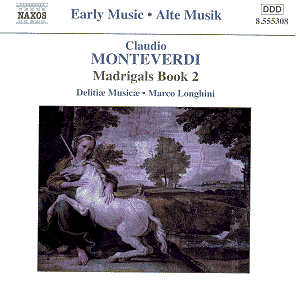The Second Book of
Madrigals was published in 1590, when
Monteverdi was just 22 years old. It
was dedicated to Giacomo Ricardi, who
was an influential figure in Milan.
It is possible that this was Monteverdi’s
way of thanking Ricardi for recommending
him to the Gonzaga family where Monteverdi
was engaged as a player of the violin
and viola da gamba at that time.
Of the 21 poems set
to music in this collection 11 are by
Torquato Tasso. There could be two reasons
for this. Tasso was a great favourite
of the Gonzagas, so choosing his poems
to set to music could be another attempt
to recommend himself to the court of
this family in Mantua.
But the choice of Tasso’s
poems also reflect a change in the style
of composing by Monteverdi. In this
book he moves towards the "form
without a form", as the ensemble’s
director Marco Longhini calls it in
the liner notes. There is a stronger
expression of the text in the music,
which Tasso’s poems strongly evoke.
There is also a change from a horizontal
to a more vertical writing: Monteverdi
is starting to use harmony deliberately
to express the text. He also uses combinations
of voices to emphasize elements in the
text and creating contrasts within the
pieces.
There is a lot word
painting in these madrigals, which is
amply described in the booklet. Monteverdi
was clearly inspired by the concrete
and vivid images Tasso uses in his poems.
Whether a poem is about love or nature,
Monteverdi is able to translate Tasso’s
images in music quite beautifully. Contrasts
within a poem are exploited to the full
and sometimes a sudden pause is used
to enhance the tension (for example
before the last line of ‘E dicea l’una
sospirand’allora’).
This recording is the
second of the ensemble Delitiae Musicae
dedicated to the madrigals of Monteverdi.
It is different from others in that
only male voices are used. Although
Marco Longhini acknowledges that women
were singing at the courts he believes
that this practice was rather the exception
than the rule.
Another feature of
this interpretation is the use of instruments.
Sometimes a viola da gamba is used,
reflecting the fact that Monteverdi
was famous as a viol player. Lute and
harpsichord provide a ‘basso seguente’
accompaniment: the lowest vocal notes
are doubled with no improvisation except
on the opening and closing chords.
The use of mean-tone
temperament leads to strong dissonances
and beautifully pure chords on consonances.
This is an exceptionally
good performance, which is totally oriented
towards expressing the text. Strong
dynamic contrasts are applied in ‘Se
tu mi lassi, perfida’ (If you leave
me, faithless one, yours will be the
pain). The lighthearted character of
‘S’andasse Amor a caccia’ (Were Love
to go out hunting) can hardly be more
vividly illustrated as it is done here.
Ornamentation is used to strengthen
the ‘affect’ of some words, like the
‘trillo’ (a quick repetition of a single
note) on "pianti" (tears)
in the very first madrigal on this disc.
Some words are stretched to emphasize
them, like "dolente" (pain)
in ‘La bocca onde l’asprissime parole’.
‘Non m’è grave ‘l morire’ (Dying
means little to me) is a perfect illustration
of the qualities of this performance:
the effective use of ‘messa di voce’,
the eloquent realisation of the declamatory
passages, the dramatic pauses and the
use of the trillo on "lagrimar"
in the highly emotional closing line
(weeping tears of pity at my death)
make this piece one of the highlights
of this recording.
All singers are Italian
and their pronunciation and articulation
is natural and idiomatic, which is a
prerequisite for a convincing performance
of this kind of music. They produce
a beautiful sound, both individually
and as an ensemble.
In most madrigals the
two upper voices are sung by the two
male altos. Since they are not very
different in timbre it was a clever
decision to put them on both ends of
the spectrum. The balance within the
ensemble is good, although sometimes
the middle voices are not clear enough
and a little overshadowed by the higher
and the lower voices.
The instruments are
tastefully used in about half of the
madrigals. The harpsichord can become
quite obtrusive in music like this,
but that is not the case here.
I regret the decision
to use a church as the venue for this
recording, though. The effect of some
pauses would have been even more striking
without the reverberation present here.
To sum up: a fascinating
performance of highly expressive madrigals
which aren’t that often performed and
recorded. And I sincerely hope this
ensemble will get the opportunity to
record the next books of madrigals as
well.
Johan van Veen

